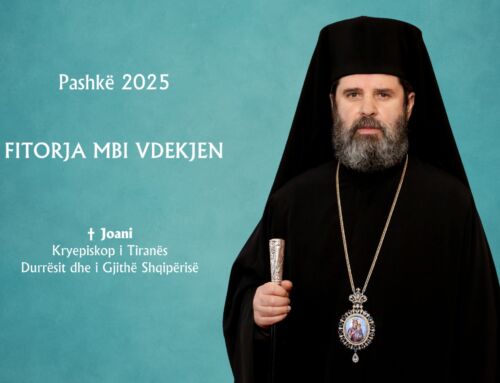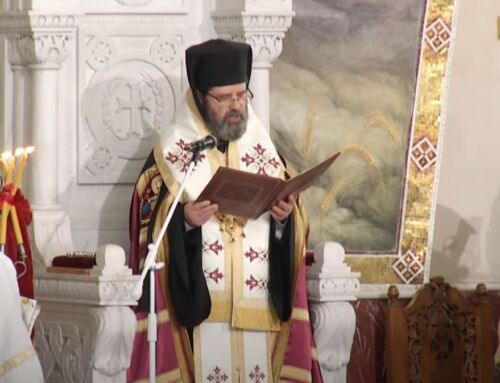The 1150th anniversary of the arrival in the province of Moravia of the brothers from Thessalonica, Cyril and Methodios, and the beginning of their missionary work to evangelize the Slavic people (today the Czechs and Slovaks) was celebrated. The event took place around the year 863, when the King Morav Rastislav directed a request to the Byzantine Emperor for the Orthodox Church to send missionaries to teach his people about the Christian faith and then to baptize them. His request was agreed to and immediately the Ecumenical Patriarch Photius the Great decided to send two local missionaries, Constantine the philosopher and Methodios.
They were the sons of a well-known leader and archon from Thessalonica, highly educated and cultured. Constantine, who a few days before his death become monk and took the name Cyril, had studied in the capital of Byzantine and taught at the first University of Medieval Studies in Magnavra of Constantinople, where he was known to Photius before he was elected as Patriarch.
Even though their work was filled with difficulties, danger and obstacles, it was crowned with success. Constantine with prayers and the enlightenment of the Holy Spirit, created the Slavic alphabet, which bears until today his name. However, many difficulties; bad weather conditions and poor health precipitated his departure from this world in 869. His work was continued by his brother Methodios, who was later, elevated as a bishop, becoming the first Bishop of Moravia. Both of the brothers from Thessalonica are honored by all the Slavic people (mainly Czechs, Slovaks and Bulgarians) not only as religious luminaries, but as the founders of their language and culture.
On the occasion of this anniversary the whole year of 2013 is dedicated to the two saints and the Orthodox Autocephalous Church of the Czech Republic and Slovakia in cooperation with the state authorities, with the Higher Institutions, Education (Universities) and cultural (museums), and with other institutions in the fields of Art and Literature who have organized various activities to honor the great spiritual contribution that the saints have given them.
These celebrations culminated on the 23-25th of May when through the invitation of the Orthodox Autocephalous Church of the Czech Republic and Slovakia, representatives from all the Patriarchates and from local Autocephalous Churches visited and participated in the celebrations. The Orthodox Autocephalous Church of Albania was represented by Archimandrite Kozma Sovjani. The Ecumenical Patriarch, His Holiness Bartholomew, took part in these celebrations as the successor of Photius the Great. On May 25 on the occasion of the feast of Cyril and Methodios (according to the Julian calendar) a Divine Liturgy was held in the archaeological territory of Mikulcice, which according to the tradition of the local archaeologists, was the place where the saints began their missionary activity. This Divine Liturgy was led by His Holiness, Ecumenical Patriarch, Bartholomew, with the participation of the representatives of the Patriarchates and of the local Autocephalous Churches.
The Patriarch in his message emphasized “… the diachronic values of the Gospel, which the great Byzantine theologians, Cyril and Methodios, planted in the hearts of local people. These spiritual values direct men in the correct way of salvation, passing by the way of the sacrifice of the Cross of Christ in the joy of the Resurrection. These values are needed even for the man of the present age, of the troubled, confused world, in order to overcome any crisis faced in his life, whenever he is far from the presence of God ….”
After the Divine Liturgy, which was broadcast live by the national television, His Holiness and some of the assembly visited the archaeological Mikulcice territory. The cultural activities that took place during these days were, among others, the inauguration of the Exhibition at the National Museum of Moravia in Brno, which contained historical material from the life and activity of the two saints, as well as the Czech artistic film, “Constantine the Philosopher and Methodios” (2013 production) in Hodonin. We note that for the first time worldwide a film was made with motifs from the life and missionary activity of the two brothers. Viewing the scenes of the film (the difficulties, the dangers, their struggles and their work) many of the participants were moved and at the conclusion they applauded continuously which was an indication that the movie was liked very much.
And truly the work of these Byzantine Missionaries is to admired. They left the comfort of their lives (because Constantinople was at that time the most developed city in the world), endured different misfortunes of life, and persecution and obeyed the divine desire to bring the light of Christ and Orthodoxy to people who were living in darkness. Rightly they are recognized by the Church as equal to apostles and constitute living examples to be imitated by all of us.
By Archimandrite Kozma Sovjani





